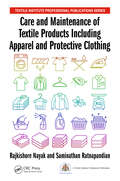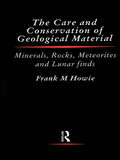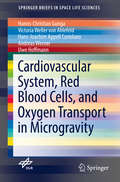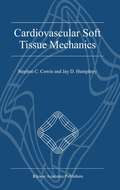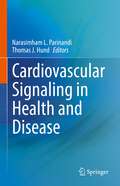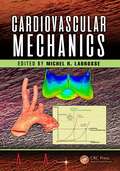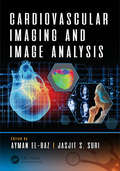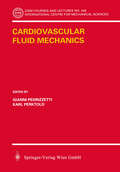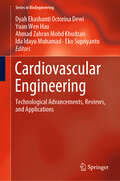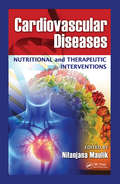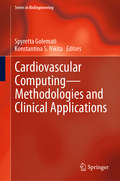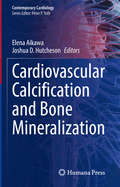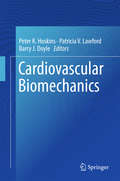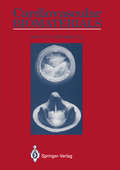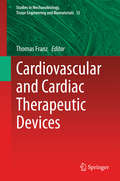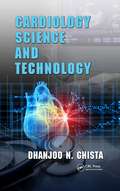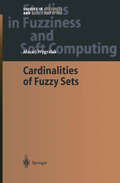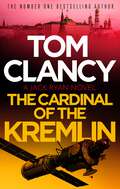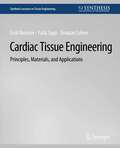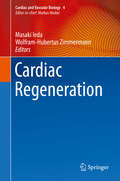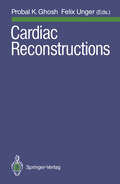- Table View
- List View
Care and Maintenance of Textile Products Including Apparel and Protective Clothing (Textile Institute Professional Publications)
by Rajkishore Nayak Saminathan RatnapandianProper care and maintenance of textile materials is essential in prolonging their durability and appearance. This books describes methods of care and maintenance for textile products, focusing on types of laundering and dry-cleaning processes, chemicals, and equipment, while considering the environmental impacts of these procedures and green cleaning approaches. It details care labelling of garments, including electronic care labelling and instructions for different specialty textiles. Factors such as pilling, abrasion, snagging, color fading, and dimensional change are discussed. This book also emphasizes care and maintenance of textiles used for protection from fire, bullets, cold weather, and chemicals.
Care and Maintenance of Textile Products Including Apparel and Protective Clothing (Textile Institute Professional Publications)
by Rajkishore Nayak Saminathan RatnapandianProper care and maintenance of textile materials is essential in prolonging their durability and appearance. This books describes methods of care and maintenance for textile products, focusing on types of laundering and dry-cleaning processes, chemicals, and equipment, while considering the environmental impacts of these procedures and green cleaning approaches. It details care labelling of garments, including electronic care labelling and instructions for different specialty textiles. Factors such as pilling, abrasion, snagging, color fading, and dimensional change are discussed. This book also emphasizes care and maintenance of textiles used for protection from fire, bullets, cold weather, and chemicals.
Care and Conservation of Geological Material
by Frank HowieThis is the first book to specifically address the preservation of an increasingly important group of materials. Techniques for processing minerals and rocks in the field and laboratory are outlined as well as the effects of treatments on specimens. Readership: Professional museum staff, curators and conservators, scientists and technicians; Students of mineralogy, private collectors.
Care and Conservation of Geological Material
by Frank HowieThis is the first book to specifically address the preservation of an increasingly important group of materials. Techniques for processing minerals and rocks in the field and laboratory are outlined as well as the effects of treatments on specimens. Readership: Professional museum staff, curators and conservators, scientists and technicians; Students of mineralogy, private collectors.
Cardiovascular System, Red Blood Cells, and Oxygen Transport in Microgravity (SpringerBriefs in Space Life Sciences)
by Hanns-Christian Gunga Victoria Weller Ahlefeld Hans-Joachim Appell Coriolano Andreas Werner Uwe HoffmannThis book comprehensively describes the physiological changes and consequences that occur in humans during spaceflight. It specifically presents the adaptations of the cardiovascular and the respiratory system. Specific changes occurring after 10, 20 or more days in space are depicted. Furthermore, the book explains various effective countermeasures that are required upon return of the astronauts to Earth. The book is a must-have for all biomedical and clinical researchers in the field of cardiovascular biology and respiration, and a fascinating reading for all interested laymen, who wish to understand a bit more about spaceflight research and technology.
Cardiovascular Soft Tissue Mechanics
by Stephen C. Cowin Jay D. HumphreyThis special volume of the Journal of Elasticity represents the first in a new p- gram dedicated to the occasional publication of collections of invited, reviewed papers of topical interest. The purpose of this program is to spotlight the dev- opments and applications in the mechanics of materials within specific areas that can enhance growth and provide insight for the advancement of the field as well as promote fundamental understanding and basic discovery. Soft Tissue Mechanics is an area of biomechanics that draws heavily upon f- damental ideas and material models from nonlinear elasticity and viscoelasticity. A major goal of this research is to understand those mechanics properties of heart, artery, collagen and skeletal muscle tissue that can be used for the diagnosis of health problems and the improvement of human life. This volume illustrates how experiment, modeling and computation is currently employed in this emerging field. May 2001 ROGER FOSDICK Editor-in-Chief Journal of Elasticity 61: ix–xii, 2000. ix Preface There are two primary areas for the application of elasticity in the biomechanics of tissues: hard tissue mechanics (e.g., bone, teeth, horns, etc.) and soft tissue - chanics (e.g., skin, tendons, arteries, etc.). The distinguishing feature between these tissue types is the amount of physiological “normal” deformation they experience. While “hard” tissues only experience small deformations, soft tissues typically experience large deformations. From a biomechanics viewpoint soft tissues fall within the realm of finite elasticity.
Cardiovascular Signaling in Health and Disease
by Narasimham L. Parinandi Thomas J. HundThis contributed volume focuses on cardiovascular diseases (CVDs), and explores the ways in which signaling mechanisms at the biochemical, molecular, and cellular levels in the blood vessels (vascular) and heart contribute to the underlying causes of development and progression of the CVDs. This volume covers unique topics such as oxidant signaling in vascular and heart diseases and health, cytoskeletal signaling in vascular health and disease, phospholipase signaling in CVDs, lipid signaling in vascular and myocardial health and diseases, and drug discovery in cellular signaling for cardiovascular diseases.This book assembles the most important discoveries made by leaders on the cellular signaling mechanisms operating behind the development and progression of life-threatening CVDs. It is an extremely useful resource for the investigators in the field of CVDs, and opens the discussion for further discovery of efficient management and effective treatment of the CVDs.
Cardiovascular Mechanics
by Michel R. LabrosseThe objective of this book is to illustrate in specific detail how cardiovascular mechanics stands as a common pillar supporting such different clinical successes as drugs for high blood pressure, prosthetic heart valves and coronary artery bypass grafting, among others. This information is conveyed through a comprehensive treatment of the overarching principles and theories that are behind mechanobiological processes, aortic and arterial mechanics, atherosclerosis, blood and microcirculation, hear valve mechanics, as well as medical devices and drugs. Examines all major theoretical and practical aspects of mechanical forces related to the cardiovascular system. Discusses a unique coverage of mechanical changes related to an aging cardiovascular system. Provides an overview of experimental methods in cardiovascular mechanics. Written by world-class researchers from Canada, the US and EU. Extensive references are provided at the end of each chapter to enhance further study. Michel R. Labrosse is the founder of the Cardiovascular Mechanics Laboratory at the University of Ottawa, where he is a full professor within the Department of Mechanical Engineering. He has been an active researcher in academia along with being heavily associated with the University of Ottawa Heart Institute. He has authored or co-authored over 90 refereed communications, and supervised or co-supervised over 40 graduate students and post-docs.
Cardiovascular Mechanics
by Michel R. LabrosseThe objective of this book is to illustrate in specific detail how cardiovascular mechanics stands as a common pillar supporting such different clinical successes as drugs for high blood pressure, prosthetic heart valves and coronary artery bypass grafting, among others. This information is conveyed through a comprehensive treatment of the overarching principles and theories that are behind mechanobiological processes, aortic and arterial mechanics, atherosclerosis, blood and microcirculation, hear valve mechanics, as well as medical devices and drugs. Examines all major theoretical and practical aspects of mechanical forces related to the cardiovascular system. Discusses a unique coverage of mechanical changes related to an aging cardiovascular system. Provides an overview of experimental methods in cardiovascular mechanics. Written by world-class researchers from Canada, the US and EU. Extensive references are provided at the end of each chapter to enhance further study. Michel R. Labrosse is the founder of the Cardiovascular Mechanics Laboratory at the University of Ottawa, where he is a full professor within the Department of Mechanical Engineering. He has been an active researcher in academia along with being heavily associated with the University of Ottawa Heart Institute. He has authored or co-authored over 90 refereed communications, and supervised or co-supervised over 40 graduate students and post-docs.
Cardiovascular Imaging and Image Analysis
by Ayman El-Baz Jasjit S. SuriThis book covers the state-of-the-art approaches for automated non-invasive systems for early cardiovascular disease diagnosis. It includes several prominent imaging modalities such as MRI, CT, and PET technologies. There is a special emphasis placed on automated imaging analysis techniques, which are important to biomedical imaging analysis of the cardiovascular system. Novel 4D based approach is a unique characteristic of this product. This is a comprehensive multi-contributed reference work that will detail the latest developments in spatial, temporal, and functional cardiac imaging. The main aim of this book is to help advance scientific research within the broad field of early detection of cardiovascular disease. This book focuses on major trends and challenges in this area, and it presents work aimed to identify new techniques and their use in biomedical image analysis. Key Features: Includes state-of-the art 4D cardiac image analysis Explores the aspect of automated segmentation of cardiac CT and MR images utilizing both 3D and 4D techniques Provides a novel procedure for improving full-cardiac strain estimation in 3D image appearance characteristics Includes extensive references at the end of each chapter to enhance further study
Cardiovascular Imaging and Image Analysis
by Ayman El-Baz Jasjit S. SuriThis book covers the state-of-the-art approaches for automated non-invasive systems for early cardiovascular disease diagnosis. It includes several prominent imaging modalities such as MRI, CT, and PET technologies. There is a special emphasis placed on automated imaging analysis techniques, which are important to biomedical imaging analysis of the cardiovascular system. Novel 4D based approach is a unique characteristic of this product. This is a comprehensive multi-contributed reference work that will detail the latest developments in spatial, temporal, and functional cardiac imaging. The main aim of this book is to help advance scientific research within the broad field of early detection of cardiovascular disease. This book focuses on major trends and challenges in this area, and it presents work aimed to identify new techniques and their use in biomedical image analysis. Key Features: Includes state-of-the art 4D cardiac image analysis Explores the aspect of automated segmentation of cardiac CT and MR images utilizing both 3D and 4D techniques Provides a novel procedure for improving full-cardiac strain estimation in 3D image appearance characteristics Includes extensive references at the end of each chapter to enhance further study
Cardiovascular Fluid Mechanics (CISM International Centre for Mechanical Sciences #446)
by Gianni Pedrizzetti Karl PerktoldThe book presents the state of the art in the interdisciplinary field of fluid mechanics applied to cardiovascular modelling. It is neither a monograph nor a collection of research papers, rather an extended review in the field. It is arranged in 4 scientific chapters each presenting thoroughly the approach of a leading research team; two additional chapters prepared by biomedical scientists present the topic by the applied perspective. A unique feature is a substantial (approx. one fourth of the book) medical introductory part, written by clinical researchers for scientific readers, that would require a large effort to be collected otherwise.
Cardiovascular Engineering: Technological Advancements, Reviews, and Applications (Series in BioEngineering)
by Dyah Ekashanti Octorina Dewi Yuan Wen Hau Ahmad Zahran Mohd Khudzari Ida Idayu Muhamad Eko SupriyantoThis book highlights recent technological advances, reviews and applications in the field of cardiovascular engineering, including medical imaging, signal processing and informatics, biomechanics, as well as biomaterials. It discusses the use of biomaterials and 3D printing for tissue-engineered heart valves, and also presents a unique combination of engineering and clinical approaches to solve cardiovascular problems. This book is a valuable resource for students, lecturers and researchers in the field of biomedical engineering.
Cardiovascular Diseases: Nutritional and Therapeutic Interventions
by Nilanjana MaulikWith cardiovascular disease remaining one of the primary causes of morbidity and mortality worldwide, there is a great need to further understand the molecular basis of this disease class and develop new therapeutic or preventative measures. Cardiovascular Diseases: Nutritional and Therapeutic Interventions presents up-to-date information on the pa
Cardiovascular Computing—Methodologies and Clinical Applications (Series in BioEngineering)
by Spyretta Golemati Konstantina S. NikitaThis book provides a comprehensive guide to the state-of-the-art in cardiovascular computing and highlights novel directions and challenges in this constantly evolving multidisciplinary field. The topics covered span a wide range of methods and clinical applications of cardiovascular computing, including advanced technologies for the acquisition and analysis of signals and images, cardiovascular informatics, and mathematical and computational modeling.
Cardiovascular Calcification and Bone Mineralization (Contemporary Cardiology)
by Elena Aikawa Joshua D. HutchesonThe book covers the basic science and clinical aspects of cardiovascular calcification and bone mineralization. Cardiovascular calcification is the leading predictor of cardiovascular morbidity and mortality, with a predictive value more significant than blood lipid levels. The presence of calcific mineral in cardiovascular tissues alters biomechanical performance, increasing workload on the heart and potentiating atherosclerotic plaque rupture and subsequent heart attack and stroke. This book examines the role of calcification in cardiovascular disease covering topics such as calcification in the atherosclerotic plaques and aortic valves arteries and valves, aortic valve replacement, peripheral artery disease, imaging of early calcification and target discovery. In addition, various forms of ectopic calcification as well as mechanisms of bone mineralization are discussed.Cardiovascular Calcification and Bone Mineralization is an essential resource for clinicians, researchers, and other medical professionals in cardiology, pathology, and biomedical engineering.
Cardiovascular Biomechanics
by Peter R. Hoskins Patricia V. Lawford Barry J. DoyleThis book provides a balanced presentation of the fundamental principles of cardiovascular biomechanics research, as well as its valuable clinical applications. Pursuing an integrated approach at the interface of the life sciences, physics and engineering, it also includes extensive images to explain the concepts discussed.With a focus on explaining the underlying principles, this book examines the physiology and mechanics of circulation, mechanobiology and the biomechanics of different components of the cardiovascular system, in-vivo techniques, in-vitro techniques, and the medical applications of this research.Written for undergraduate and postgraduate students and including sample problems at the end of each chapter, this interdisciplinary text provides an essential introduction to the topic. It is also an ideal reference text for researchers and clinical practitioners, and will benefit a wide range of students and researchers including engineers, physicists, biologists and clinicians who are interested in the area of cardiovascular biomechanics.
Cardiovascular Biomaterials
by Garth W. HastingsCardiovascular Biomaterials presents current research material developed by contributors from universities and professional laboratories in the UK, USA, Canada, and Germany.
Cardiovascular and Cardiac Therapeutic Devices (Studies in Mechanobiology, Tissue Engineering and Biomaterials #15)
by Thomas FranzThis volume focuses on latest research in therapeutic devices for cardiovascular, i.e. vascular and valvular and cardiac diseases. In the area of vascular therapies, aspects covered relate to latest research in small-diameter tissue-regenerative vascular grafts, one of the greatest persisting challenges in cardiovascular therapies, stent grafts and endovascular stents for percutaneous arterial interventions. Contributions on valvular therapies focus on tissue engineered and tissue regenerative prosthetic heart valves and valvular prostheses for trans-apical implantation including the challenges posed on the prosthesis design. The section on cardiac diseases aims at covering therapeutic advances for myocardial infarction and prevention of heart failure and on in vivo biomechanics of implantable cardiac pacemaker devices. A further section complements these three areas by presenting constitutive modelling of soft biological tissues of the cardiovascular system, an area imperative for advanced numerical and computational modelling in the development and optimisation of cardiovascular devices and therapies.
Cardiology Science and Technology
by Dhanjoo N. GhistaCardiology Science and Technology comprehensively deals with the science and biomedical engineering formulations of cardiology. As a textbook, it addresses the teaching, research, and clinical aspects of cardiovascular medical engineering and computational cardiology. The books consists of two sections. The first section deals with left ventricular
Cardinalities of Fuzzy Sets (Studies in Fuzziness and Soft Computing #118)
by Maciej WygralakCounting is one of the basic elementary mathematical activities. It comes with two complementary aspects: to determine the number of elements of a set - and to create an ordering between the objects of counting just by counting them over. For finite sets of objects these two aspects are realized by the same type of num bers: the natural numbers. That these complementary aspects of the counting pro cess may need different kinds of numbers becomes apparent if one extends the process of counting to infinite sets. As general tools to determine numbers of elements the cardinals have been created in set theory, and set theorists have in parallel created the ordinals to count over any set of objects. For both types of numbers it is not only counting they are used for, it is also the strongly related process of calculation - especially addition and, derived from it, multiplication and even exponentiation - which is based upon these numbers. For fuzzy sets the idea of counting, in both aspects, looses its naive foundation: because it is to a large extent founded upon of the idea that there is a clear distinc tion between those objects which have to be counted - and those ones which have to be neglected for the particular counting process.
The Cardinal of the Kremlin: An electrifying Jack Ryan thriller that will have your heart racing (Jack Ryan #3)
by Tom Clancy'The best of the Jack Ryan series!' New York TimesThe superpower arms negotiations appear to be making progress. But a US spy satellite reveals that the Soviets are building a massive laser-defence system controlled from an other-worldly array of pillars and domes in the Soviet hills at Dushanbe near the border of war-torn Afghanistan.The Americans need more information. The man to give it is Colonel Mikhail Filitov of the Soviet Union, codename Cardinal, America's highest-placed agent in the Kremlin. But Filitov's cover is about to be betrayed to the KGB, and CIA adviser Jack Ryan must rescue Filitov and bring him to safety . . .
Cardiac Tissue Engineering (Synthesis Lectures on Tissue Engineering)
by Smadar Cohen Emil Ruvinov Yulia SapirCardiac tissue engineering aims at repairing damaged heart muscle and producing human cardiac tissues for application in drug toxicity studies. This book offers a comprehensive overview of the cardiac tissue engineering strategies, including presenting and discussing the various concepts in use, research directions and applications. Essential basic information on the major components in cardiac tissue engineering, namely cell sources and biomaterials, is firstly presented to the readers, followed by a detailed description of their implementation in different strategies, broadly divided to cellular and acellular ones. In cellular approaches, the biomaterials are used to increase cell retention after implantation or as scaffolds when bioengineering the cardiac patch, in vitro. In acellular approaches, the biomaterials are used as ECM replacement for damaged cardiac ECM after MI, or, in combination with growth factors, the biomaterials assume an additional function as a depot for prolonged factor activity for the effective recruitment of repairing cells. The book also presents technological innovations aimed to improve the quality of the cardiac patches, such as bioreactor applications, stimulation patterns and prevascularization. This book could be of interest not only from an educational perspective (i.e. for graduate students), but also for researchers and medical professionals, to offer them fresh views on novel and powerful treatment strategies. We hope that the reader will find a broad spectrum of ideas and possibilities described in this book both interesting and convincing. Table of Contents: Introduction / The Heart: Structure, Cardiovascular Diseases, and Regeneration / Cell Sources for Cardiac Tissue Engineering / Biomaterials: Polymers, Scaffolds, and Basic Design Criteria / Biomaterials as Vehicles for Stem Cell Delivery and Retention in the Infarct / Bioengineering of Cardiac Patches, In Vitro / Perfusion Bioreactors and Stimulation Patterns in Cardiac Tissue Engineering / Vascularization of Cardiac Patches / Acellular Biomaterials for Cardiac Repair / Biomaterial-based Controlled Delivery of Bioactive Molecules for Myocardial Regeneration
Cardiac Regeneration (Cardiac and Vascular Biology)
by Masaki Ieda Wolfram-Hubertus ZimmermannThis Volume of the series Cardiac and Vascular Biology offers a comprehensive and exciting, state-of-the-art work on the current options and potentials of cardiac regeneration and repair.Several techniques and approaches have been developed for heart failure repair: direct injection of cells, programming of scar tissue into functional myocardium, and tissue-engineered heart muscle support. The book introduces the rationale for these different approaches in cell-based heart regeneration and discusses the most important considerations for clinical translation. Expert authors discuss when, why, and how heart muscle can be salvaged.The book represents a valuable resource for stem cell researchers, cardiologists, bioengineers, and biomedical scientists studying cardiac function and regeneration.
Cardiac Reconstructions
by Probal K. Ghosh Felix UngerAttempts to reconstruct various parts of the heart started even before the beginning of open cardiac surgery. By the late 1950s and early 1960 s several closed and open procedures had already been described. In that era, several surgeons in Europe and the Americas were particularly prompted to develop various techniques of valve re construction because of the lack of acceptable valve prostheses and conduits which have become available subsequently. At that time, several congenital lesions still defied definitive correction, and clinical attempts at left ventricular wall replacement had not yet got under way. A renaissance in different cardiac reconstructive procedures started at the beginning of the 1980s. As the problems relating to valve prostheses became more generally appreciated and the importance of chamber volumes and geometry (atrial or ventricular) was accorded due importance in the long-term follow-up, there was a resurgence of surgical attempts at reconstruction in congenital and acquired cardiac lesions so as to approximate the natural state. At the same time several characteristics of this reconstructive "discipline" became apparent. First, cardiac reconstructive surgery has remained a surgical "art" with a gradually increasing number of interested cardiac surgeons.
